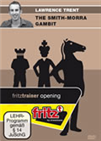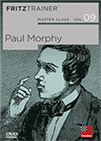A review
 What do you do against the Sicilian Defence? Do you play a mainline, safe in the knowledge that despite being the most reliable way to gain an opening advantage, you could be condemned to spending years studying a huge body of opening theory, or do you choose an Anti-Sicilian, a way to sidestep the mainlines at the risk of allowing Black to have a sneaking chance to achieve equality?
What do you do against the Sicilian Defence? Do you play a mainline, safe in the knowledge that despite being the most reliable way to gain an opening advantage, you could be condemned to spending years studying a huge body of opening theory, or do you choose an Anti-Sicilian, a way to sidestep the mainlines at the risk of allowing Black to have a sneaking chance to achieve equality?As an active chess player, with about 80 to 100 tournament games a year, I tend to worry about my openings a lot. The point being that it is nice to know the endgames, but if by move 25 I've lost the game, to know all about endgames will not help me much.
I study the openings, not as memorization of the moves, but as piece placement, and treatment of the pawn structures. Michael Rahal immediately appealed to my way of studying, when in his introductory video showed piece placement:

As you can see from the diagram, one doesn't need to memorize lines, because he already knows where the pieces should go. If one adds Rahal's explanation of why the pieces go there, this is the opening understanding everyone should be looking for, when studying an opening.
Another very useful teaching method employed by Rahal throughout the DVD is to explain the pawn structures used by Black. Together with how White must deal with them. The diagram below shows an example of a pawn structure akin to the Scheveningen Sicilian, highlighted by Rahal. His explanation is of central importance for learning how to play against it, using the Smith-Morra gambit:

Personally, I also tend to revisit openings I've studied and played before, in order to build an opening repertoire which adapts to different time controls. Here in the USA these days we have three main time controls: long time controls (which compared to the long time controls in Fischer's time is more akin to blitz — in the 70s they even had adjournments!) then "Quick chess" time controls when the game is played in 30 minutes or less, and of course Blitz. Maybe one day they'll introduce bullet.
In Blitz and Rapid, we just had a national championship — in a city about five hours drive from mine — which was well attended, showing the chess population is interested in these events. The correct opening repertoire can be quite useful in gaining rating points, and avoiding the opponent opening prep. This can be done only if one creates three different opening repertoires, one for long time controls, one for rapid, and one for blitz.
Michael Rahal, being a trainer, suggests some further benefits to teach this opening to young players. His motivations are: it will teach them to play for the initiative, calculation, and tactics. Yes, this is another very important point. To become familiar with the peculiar tactics one must study them in the context of the opening one plays. To solve tactics just for solving them, it can be beneficial, but will not help us in winning games.
I didn't follow the DVD chronological order, because I was curious. I played this opening before and got slammed when facing the Siberian defence, my opponent was a very strong player, and Rahal — in the introductory video to the Siberian defence — mentions it immediately: this is the professional way Black defends...

For those who like me prefer action to words, try to play against the engine, and find the right move to continue as White: 1.e4 c5 2.d4 cxd4 3.c3 dxc3 4.Nxc3 e6 5.Nf3 Nc6 6.Bc4, Qc7 7.0-0 Nf6
Then continuing the DVD I went to see the Chicago defence — mainly because I have a lot of chess friends from Chicago, and I know it is a very active chess city, and of course, it deserves to be mentioned: the birthplace of the greatest champion of all: Bobby Fischer!

We have the Chicago Defence, and its key move Ra7, after the moves: 1.e4 c5 2.d4 cxd4 3. c3 dxc3 4.Nxc3 e6 5.Nf3 a6 6.Bc4 d6 7.0-0 Nc6 8.Qe2 b5 9.Bb3 Ra7
 Learn about one of the greatest geniuses in the history of chess! Paul Morphy's career (1837-1884) lasted only a few years and yet he managed to defeat the best chess players of his time.
Learn about one of the greatest geniuses in the history of chess! Paul Morphy's career (1837-1884) lasted only a few years and yet he managed to defeat the best chess players of his time.One can try this position against the engine, and then watch the DVD gain some deeper insight into what works, and what doesn't.
Coming to the content of the DVD itself, Rahal has divided the material into eight chapters, based on possible pawn structures we find in the Sicilian, which can be applied against the Smith-Morra. For each one he outlines the pro and cons of the structure, and gives the lines and moves one should play. Rahal in the last chapter also treats declining the Smith-Morra. The last part of the DVD is made up of a test section.
The DVD comes with one database of 60 model games, which span from 1858 (Morphy) to 2018. And another Database with 90 games/lines, practically the analysis material found in the videos, with fragments and entire games used as a theoretical base for the videos. All this material is grouped in this other database, with some headers to define different sections, and helping us find what we are looking for.
Pro and Con
As a reviewer, I just state what are my findings. For example, I found only one game by Michael Rahal with B21 the ECO in which we find the Smith-Morra, and it was as Black, not as White. So I don't know if he ever played it in big tournaments. Honestly, I don't know if it's important, because often we need to find some heroes for the opening we want to learn. Often those heroes, being top-rated players don't have time for teaching. I'd love to have Caruana make a DVD teaching the Petroff defence (1.e4 e4 2.Nf3 Nf6) [how about Caruana's second Kasimdzhanov on the Petroff?! -Ed.], but I doubt he will ever find the time. While someone who is not at that above-and-beyond level, may be passionate and teach me the opening better than the best player in the world. For example, I found the text used in the introductory DVD, which explained the origin and historical development of the Smith-Morra, to be quite informative. Proving a DVD, and the right author can be more instructive than a champion playing that opening.
I must say I like Rahal very much, because he began the DVD with two games as appetizers, to stimulate our hunger for playing this opening, and this is what a teacher must do, pass the passion to the pupils, because on account of that passion — that fire we receive from the teacher — we will persevere when times are tough, study harder and invest our energies into learning this exciting opening.
Rahal is also great at discussing the fine points of piece placement. In which square we have to develop a bishop, say, and why. I found it very important, because often after a tournament game we discover we didn't place a piece in the right place, and live to regret it.
Before concluding this review, I'd love to share with my fellow chess players few games with the Smith-Morra, which I found aesthetically pleasing. In a world where unfortunately tragedy and misery are ordinary, to just take five minutes off to admire pure beauty, can be quite refreshing.
Final thoughts
This DVD is a way to refresh one's knowledge of the Smith-Morra, if played it before, while seeing a new perspective from a different teacher. Rahal's presentation is top of the line, he is quite adept in showing the most important points, and the crucial lines one must know. He takes into account Black's best plans and tells the viewer when to play tactically, or when switch gears and play positionally. The four hours of videos are complemented by a great database of games one must study. Thanks to the integration of ChessBase 14 and Fritz one can practice the positions against an engine, and be ready to deploy this opening at tournament level in no time.
The Smith-Morra Gambit (1.e4 c5 2.d4!) is a great attacking weapon against the popular Sicilian . On move two White sacrifices a pawn for fast development and good attacking chances, and Black can easily fall into one of the many devious opening traps.
Links
























